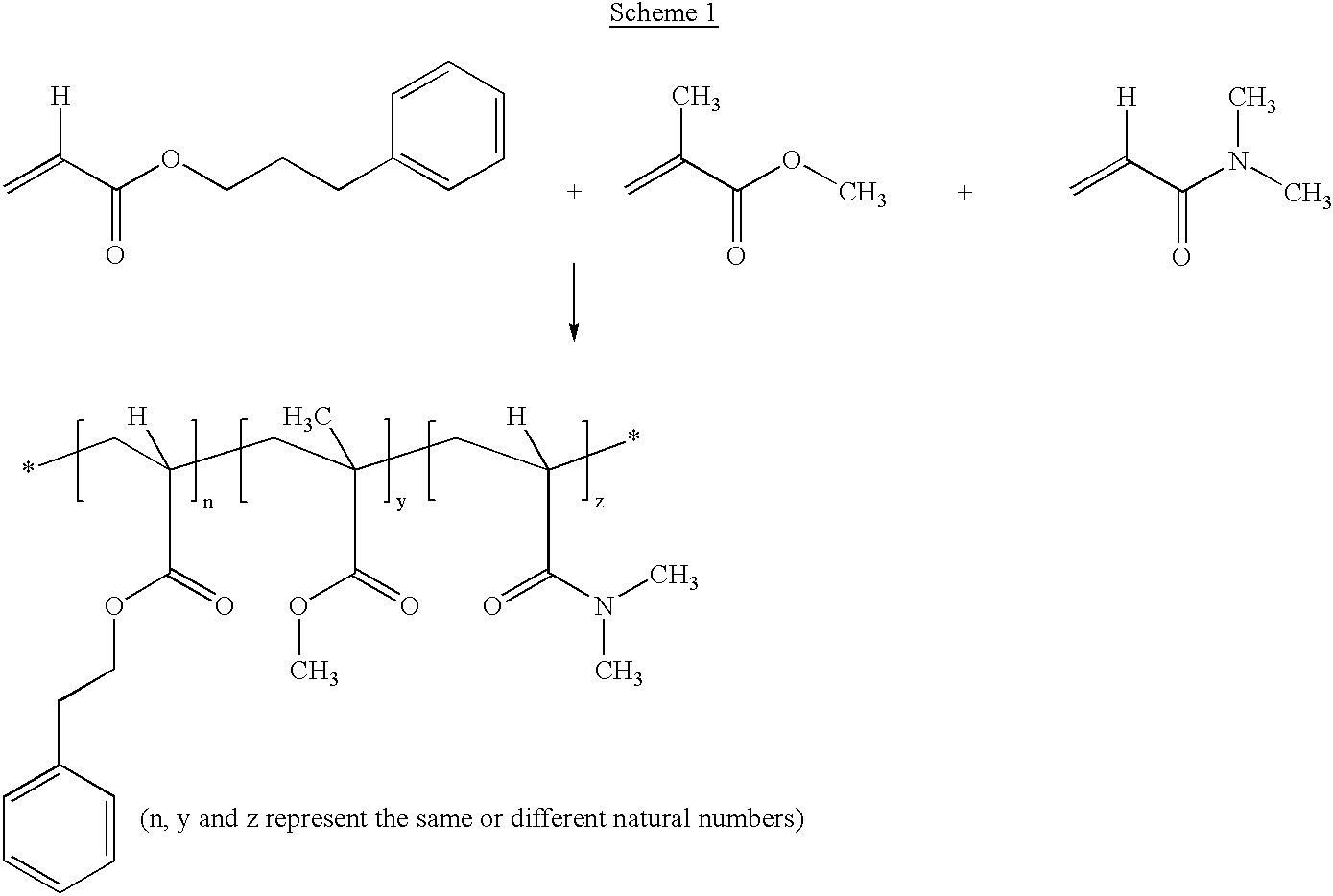Low water content, high refractive index, flexible, polymeric compositions
a polymer composition and low water content technology, applied in the field of polymer compositions, can solve the problems of less popularization of rigid iol implants in the market, increased incidence of postoperative complications, and less desirable than other materials with respect to minimal incision size, and achieve ideal physical properties for manufacture, high refractive index, and high elongation polymeric compositions
- Summary
- Abstract
- Description
- Claims
- Application Information
AI Technical Summary
Benefits of technology
Problems solved by technology
Method used
Image
Examples
example 1
A film was cast using 65 parts phenylpropyl acrylate, 25 parts dimethylacrylamide, 10 parts methacryloyloxypropyl diphenylmethylsilane, 3 parts ethylene glycol dimethacrylate and 0.5 percent by weight bis(2,4,6-trimethylbenzoyl)-phenylphosphine oxide, i.e., Irgacure™ 819 photoinitiator. The cure conditions consisted of a two-hour ultraviolet irradiation. The films were then extracted in isopropanol for 24 hours, air dried and then hydrated in a borate buffered saline. The resultant films possessed a modulus of 143 g / mm2, a tear strength of 57 g / mm and a water content of 5.7 percent by weight.
example 2
A film was cast using 65 parts phenylpropyl acrylate, 30 parts methyl methacrylate, 35 parts dimethylacrylamide, 3 parts ethylene glycol dimethacrylate and 0.5 percent by weight bis(2,4,6-trimethylbenzoyl)-phenylphosphine oxide, i.e., Irgacure 819 photoinitiator. The cure conditions consisted of a two-hour ultraviolet irradiation. The films were extracted in isopropanol for 24 hours, air dried and then hydrated in a borate buffered saline. The resultant films possessed a modulus of 290 g / mm2, a tear strength of 127 g / mm and a water content of 11.3 percent by weight. The film was clear and showed no visible water vacoules after two months at 37° Celsius.
example 3
A film was cast using 65 parts phenylpropyl acrylate, 30 parts methyl methacrylate, 35 parts dimethylacrylamide, 3 parts ethylene glycol dimethacrylate and 0.5 percent by weight bis(2,4,6-trimethylbenzoyl)-phenylphosphine oxide, i.e., Irgacure 819 photoinitiator. The cure conditions consisted of a two-hour ultraviolet irradiation. The films were extracted in isopropanol for 24 hours, air dried and then hydrated in a borate buffered saline. The resultant films possessed a modulus of 761 g / mm2, a tear strength of 340 g / mm and a water content of 3.7 percent by weight. The film was initially transparent following hydration, yet showed water vacuoles after two months at 37° Celsius.
Ophthalmic devices such as but not limited to IOLs manufactured using the polymeric compositions of the present invention can be of any design capable of being rolled or folded for implantation through a relatively small surgical incision, i.e., 3.5 mm or less. For example, ophthalmic devices such as IOLs typi...
PUM
| Property | Measurement | Unit |
|---|---|---|
| elongation | aaaaa | aaaaa |
| refractive index | aaaaa | aaaaa |
| elongation | aaaaa | aaaaa |
Abstract
Description
Claims
Application Information
 Login to View More
Login to View More - R&D
- Intellectual Property
- Life Sciences
- Materials
- Tech Scout
- Unparalleled Data Quality
- Higher Quality Content
- 60% Fewer Hallucinations
Browse by: Latest US Patents, China's latest patents, Technical Efficacy Thesaurus, Application Domain, Technology Topic, Popular Technical Reports.
© 2025 PatSnap. All rights reserved.Legal|Privacy policy|Modern Slavery Act Transparency Statement|Sitemap|About US| Contact US: help@patsnap.com

